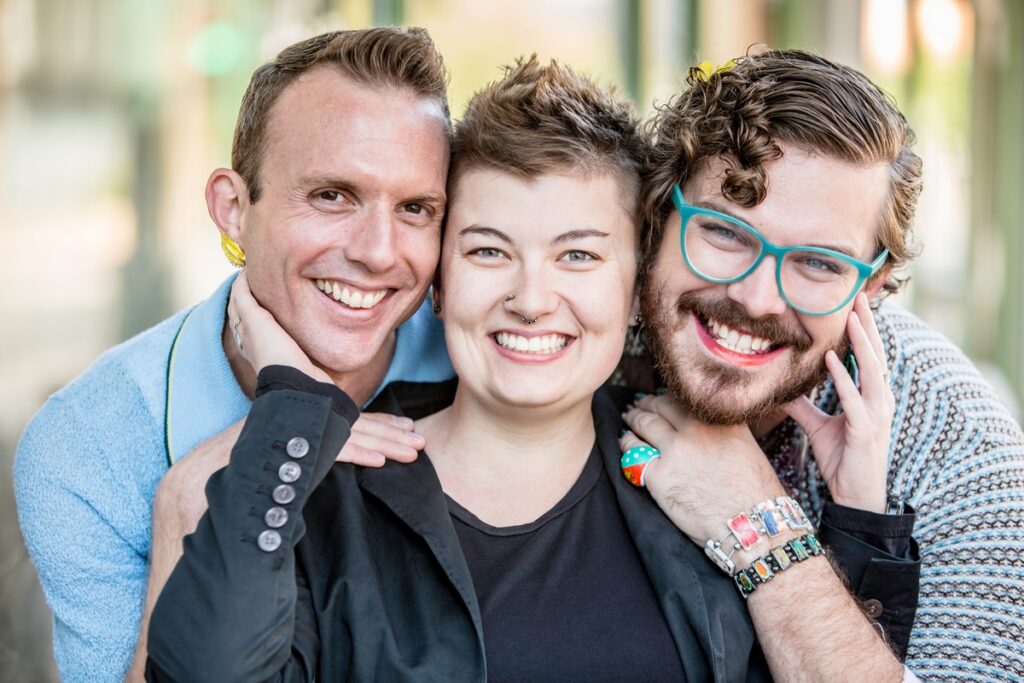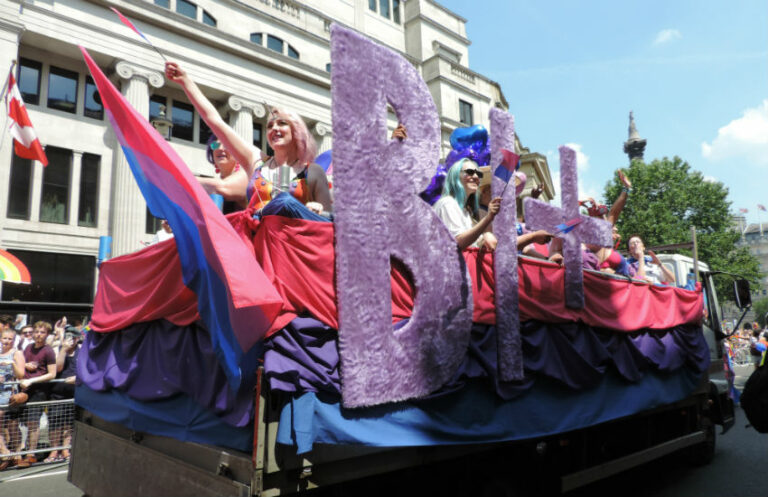Bisexuality – what is it?
Bisexuality is defined as the sexual orientation of a person who takes pleasure in having sexual and/or emotional relationships with people of both the same and the opposite sex, people for whom he or she also feels physical attraction.
One must be careful not to confuse bisexuality with hermaphroditism, a condition for which, in the same individual, there is the simultaneous presence of the anatomical sexual characteristics of both man and woman.
Bisexuality is known since ancient times and, historically, society’s assessment of this phenomenon has gone through alternating phases: appreciated by the Greek civilization (which did not accept willingly only homosexual relations), tolerated (depending on the context) by the Roman civilization, but condemned at an absolute level by the Judeo-Christian tradition.
It is not easy to quantify the extent of the phenomenon of bisexuality, according to some surveys, the percentage of bisexual people ranges between 2 and 6% of the global population, but there are doubts about the size and reliability of the samples taken into account.
Scientific study of bisexuality began in the first half of the 1900s. The first large-scale statistical survey on the sexual behavior of men was carried out by Alfred Charles Kinsey (1894-1956), an American sexologist who used the data collected to write his two best-known works (Sexual Behaviour in the Human Male (1948) and Sexual Behaviour in the Human Female (1953), written in collaboration with Wardell Pomeroy and others. Kinsey, on the basis of his findings, came to hypothesize that the majority of people had some bisexual component. In a passage of his work Kinsey states:
The world is not divided into sheep and goats. Not all things are black and white. It is the basis of taxonomy* that nature rarely deals with discrete categories. Only the human mind invents categories and tries to force facts into distinct cages. The living world is a continuum in every aspect. The sooner we learn this about human sexual behavior, the sooner we will come to a deep understanding of the realities of sex.
Kinsey, based on his studies, proposed this classification:
| Rating | Description |
| 0 | Exclusively heterosexuals |
| 1 | Predominantly heterosexual, but in some circumstances with homosexual tendencies. |
| 2 | Predominantly heterosexual, but with a strong homosexual component. |
| 3 | Heterosexual and homosexual tendencies are equivalent (bisexuality). |
| 4 | Predominantly homosexual, but with a strong heterosexual component. |
| 5 | Predominantly homosexual, but in some circumstances with heterosexual tendencies. |
| 6 | Exclusively homosexual. |
A classification on which not all scholars agree and which, among other things, does not take into account the time factor at all; in fact, many argue that a person’s sexual orientations can change as time goes on. On a social level, the bisexual person is often the victim of prejudice from both the heterosexual environment (because of its “diversity”) and the homosexual environment (the bisexual is accused of being ashamed of his true homosexual nature and mask it with a heterosexual behavior).
*Taxonomy is synonymous with systematics, a term of which we give the definition as reported by the Dictionary of the Italian language Devoto-Oli: Part of the natural sciences relating to the classification and nomenclature of living things and fossils, even the classification itself: biological systematics, zoological systematics.
The causes of bisexuality
Ideas about the causes of bisexuality do not seem very clear since the opinions surrounding the topic are the most varied: some believe bisexuality to be a normal phenomenon, others a deviation, others even argue that bisexuality does not really exist and that it is nothing more than a homosexuality in disguise. For example, one cannot deny (and some bisexual organizations also affirm this) that bisexuality can be a period of transition linked to particular periods of life (adolescence, imprisonment, etc.).
The associations of psychologists are very divided on the subject. The APA (American Psychological Association) has expressed judgments that for many bisexuals are offensive, for example the concept that the true bisexual is polygamous in nature because in fact is incapable of monogamous relationships (lacking sexual repulsion for a sex, bisexuality would be an extension of friendship that would include the sexual sphere, since we all think it is natural to have more friends, so the bisexual intimately would consider it natural to have more partners).
Other sources see bisexuality as a natural evolution of humanity (Simonelli: “a greater freedom, from stereotypes and prejudices. The phenomenon is just beginning: in order for it to take consistency we will have to wait at least two or three generations”) up to the declaration of the oncologist Umberto Veronesi (1925-2016) according to which “in the future humanity will be bisexual”. Among other things, Veronesi’s thesis is based on the fact that the organs responsible for procreation will atrophy and the production of estrogen will be lower, linking in fact bisexuality to the questionable hypothesis of a low sex drive.
In fact, it seems that everyone gives the interpretation of the phenomenon that he likes without having any particular evidence to support it.
Finally, according to a fairly widespread opinion sexual behaviors have no causes, “you are like that and that’s it”. This approach is not scientific (science always tries to explain the causes of phenomena) and probably arises only from a certain allergy to the term cause, seen as negative.
In fact, looking for the causes of a phenomenon does not mean to label it as negative and, on the sexual level, the answer “that’s just the way it is” is superficial because, for example, if accepted, it could be a good justification for “deviant” behaviors such as pedophilia, zoophilia (think of the myth of Pasiphae), necrophilia, incest (myth of Oedipus) etc.. “Those are psychopathologies, my bisexual tendency is not”, a sentence that has no rational depth, if not a certain propensity for the error of partisanship. So it is correct to understand the causes of bisexuality, because only by understanding them you can avoid making the gross mistake of considering it a pathology.
Picking up on Kinsey’s classification, categorical spacing can be better handled by judging only adults with permanent sexuality and evaluating them based on relationships alone.
| Rating | Description |
| 0 | Exclusively heterosexuals |
| 1 | Bisexual, predominantly heterosexual. |
| 2 | Bisexual, predominantly homosexual. |
| 3 | Heterosexual and homosexual tendencies are equivalent (true bisexuality). |
| 4 | Exclusively homosexual. |
The mechanism of attraction-repulsion – The physical attraction of a monosexual derives from the anatomical characteristics of the target sex (sex that is equal to one’s own for the homosexual and is opposite for the heterosexual). In the case of bisexuals, sex takes a back seat and the anatomical characteristics (not only the genitals) are not at the basis of the choice of the person with whom to have a relationship; according to Veronesi, sex will remain as a gesture of affection. In essence, the denial of the mechanism of attraction-repulsion is the cause of true bisexuality.
Bisexuality
It seems that the term “bisexuality” was coined only in the nineteenth century

Female bisexuality
From the data (not certain) of many studies it seems that bisexuality is more frequent in women than in men (about 8 times higher), but this may be due to the greater difficulty of men to declare relationships with other men. Among the famous people who are openly bisexual are actresses Angelina Jolie and Maria Bello.
Bisexuality and existential problems
As a premise let’s make it clear that heterosexuality is not a necessary condition to be balanced people. With such a statement those who consider homosexuality and bisexuality as diseases or amoral behaviors will surely be disappointed, but there is no objective reason to consider them as such.
Currently it is not clear what the percentages are, but we are inclined to believe that 5% is homosexual and 20% is bisexual (i.e. has had relationships with both sexes), especially the second percentage will surprise many, but the concept of bisexuality is not very clear, since it should be considered as such only those who are “permanently” bisexual, bisexuality can be a period of transition related to particular periods of life (adolescence, imprisonment, etc..).
For different reasons, both homosexuality and bisexuality can be penalizing for the quality of life of the person because they are subject to discrimination. It is no coincidence that the level of civilization of a country is measured by how much these discriminations are still current and strong.
For bisexuals it seems that a further complication arises from the fact that the true bisexual is polygamous in nature because in fact he is incapable of monogamous relationships (source APA, American Psychological Association).
Finally, there is a statistical reason that bisexuals may have more problems. The declaration of sexuality is a way to establish asexual relationships: a straight woman would never be interested in a gay male, nor would a straight man be interested in another man. Consider an overt (or “recognizable”) bisexual male in a workplace with a (single-sex) boss who is prone to sexual harassment; if the person is bisexual he will potentially be harassed by both a female and a male (gay) boss! What happens, however, if it is the harassing boss who is bisexual? That he will be interested in both men and women, statistically doubling the problems.
That is, the condition of bisexuality is a harbinger of greater problems than the hetero condition, also considering the fact that in many bisexual circles it is thought that bisexuality is strongly discriminated against; probably the practical discrimination is nothing but the exercise of the monosexual to freely choose his contacts and relationships.
If it is very easy for a woman to have a gay male friend (or vice versa), in order to minimize problems in life (a purely common sense choice), what sense does it make for a man (woman) to choose a bisexual woman (man)? All other things being equal, the only result he gets is to have twice as many problems, statistically to have a less stable relationship and to be powerless to understand and manage certain situations: what to do if I compete with a woman (man)?
Same with total friendship: what can a straight man (woman) expect from a bisexual man (woman)? Sex or not? No one can deny that confusion (often aggravated by the variability of the sexual inclinations of the bisexual over time) can penalize the quality of life.


